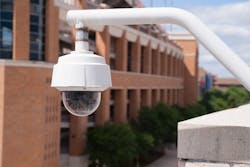Does adding more video cameras to a campus security system make it more effective? The number of cameras on higher education campuses can range from hundreds to more than a thousand. The camera feeds are then piped into elaborate video walls where security/dispatch personnel sort through it. While it looks impressive, how effective is this set up? Not very effective. This article is intended to offer guidance on how to avoid the common mistakes in video surveillance use on campus and get the maximum value from the investment. To borrow a concept from the U.S. Marine Corps, consider a timeline representing an event, “Bang,” where “Left of Bang” is the proactive side of the event and where you want to operate. Too often campuses are operating in the reactive “Right of Bang” mode with video surveillance.
The following strategies are presented to shift campus security administrators to a proactive posture:
- Classify all campus cameras by their function (s) at the earliest point when a camera is being considered. Ideally, this would be done as part of a campus security risk assessment. The function of the camera drives many other engineering factors, so it is an essential first step in determining whether it will fit the purpose in a criminal attack or not.
- Increase the intelligence of the cameras on both sides of “Bang”.
- Improve the way in which campus dispatch or security personnel interface with the video management system for enhanced incident prevention, response and investigation.
- Rightsizing the data flow, storage and dispatch interaction with the video images consistent with specific campus needs and risk mitigation strategies.
Classification of Video
The classification of the camera is an important first step. Have you ever asked why a camera is installed and nobody can answer? The table below outlines many of the common functions that cameras have on campuses.
(Chart 1)
The function of the camera is going to drive many decisions and requirements such as:
- Resolution (equates to image quality)
- Bandwidth (the amount of data moving across the network)
- Storage
- The degree to which technology should be added to help the camera to detect or alert dispatch personnel prior to or during an event. In the case where a camera is being used only for forensic purposes, there are still technologies that can enhance the investigative value of recorded video. More on this later in the article.
This information should be captured in a campus “camera schedule” which is essentially a detailed inventory of your cameras containing engineering, performance and other installation details.
Smarten Up the Cameras
There are several ways to get more value from your cameras as new technology emerges.
Proactive protection and detection capabilities – “Left of Bang”
Video analytics are improving every day. Tactics such as area protection, perimeter protection, direction control, object detection, stopped vehicle detection and tailgating detection are convention analytics offered by many video management providers. There are also video solutions emerging which combine digital video and artificial intelligence to create a capability to detect visible weapon threats, fights and even health and safety issues.
On higher education campuses, nuisance door alarms can be a significant problem. There is technology available for analyzing door alarms as they are occurring and assigning a priority to each event correlating to the probability that the event is a true security breach versus a nuisance event. This can assist in prioritizing the use of video for assessment to the events most likely to require a security or campus police dispatch. Another example is taking a common camera and elevating it from a passive forensic device to an active detection device with embedded capabilities for real-time and long-range detection.
After the fact, assistance in investigations – “Right of Bang”
For more rapid investigation there are several video solutions to consider which allow investigators to quickly search through substantial amounts of archived video and direct personnel to the most relevant footage within seconds versus hours. For example, investigative video searches could include, “I want all video where there is a red car” or “I want all video where a subject is wearing black pants” or “I want to know the time frame when an object was removed from the field of view of a camera”. In each of these cases, the appropriate video can be isolated and identified for easy and quick review.
Enhanced Engagement with Video Management System Operators
An optimal video management system would have the security cameras set up in a very logical fashion. For instance, groupings of cameras could be pulled up together. Operators should be trained on what constitutes normal or acceptable activity levels versus abnormal activity requiring further investigation. Abnormal can be defined as positive or negative attributes – something extra like people where they should not be or negative abnormalities such as a security officer away from post or critical areas not properly secured (e.g., doors, gates). Finally, in recognition that human beings are not capable of effectively monitoring video for an extended period, dispatch personnel should be scheduled to monitor video for reasonable increments of time, then rotated to another activity. In other words, directed patrols with very specific purposes ensure that when camera images are monitored, the effort is effective.
The best practices that can be seen in this configuration are:
- Grouping cameras in a functional or geographical manner to aid the VMS user in efficiently pulling up live images.
- Documenting and training VMS users on the purpose of each image, what is expected and what is abnormal in the camera’s field of view.
- Setting realistic expectations on specific video tours required and the duration where dispatch or security personnel are expected to engage with the video management system.
- Documenting when video tours are conducted in the daily activity report.
Things to Avoid in a Dispatch Center
- Arbitrary rotation of images through the monitors.
- Expecting a person’s sole duty to be monitoring video; is a waste of precious resources.
Another strategy to optimize the dispatch operator engagement with a video management system is to utilize the dark screen monitor concept and layer on a detection capability to trigger the camera’s display in the dispatch center. This is ultimately a far more reliable video architecture to ensure irregularities will be assessed and investigated in real-time. This may mean adding video analytics, which can be done in several ways (edge, software, server processed) or integrating or utilizing unified door alarm and video solutions.
Prioritization and Video Retention Considerations
Recorded Video Analysis
Recorded video duration is typically established by determining the maximum amount of time it would take to discover an incident. Common recording duration is thirty days, with every camera recording at the same duration. Both conditions leave potential opportunities for improvement. First, based on the operation of any campus, thirty days may or may not be sufficient depending on the required recording duration for forensic purposes. It is disappointing to try and recall video after an incident only to find out it is not available. To make a deliberate assessment of your video management system's existing conditions, BPS recommends video management system administrators create or amend a camera schedule. Some of the key data points to include in this camera schedule include:
- Camera name
- Location
- Function (e.g., forensic, assessment)
- Resolution
- Frames per second
- Existing recorded duration
- Required recorded duration
- Gap
To the extent that some camera durations can be reduced, you will have increased storage available for cameras requiring additional duration. A simple illustration of a four-camera deployment is shown below. In this analysis, two cameras need to have increased recording duration and two cameras can be decreased. When the bandwidth and storage calculations are done based on the newly recorded duration, the rightsizing process reduced the storage requirements overall but more importantly, every camera is recorded at the necessary duration rather than an arbitrary number applied across the board.
(Chart 2)
Prioritizing Video for Display and Monitoring
BPS developed and employed a process to classify and rank campus buildings and spaces within buildings so that each camera is given a numeric value and stratified by their relative value to campus risk mitigation. This ranking helps security leaders set the frequency for monitoring cameras, how images are grouped on wall displays and where the application of detection technology to drive camera call up in dispatch can have the greatest impact.
Summary
This article provides some “out of the box” strategies to greatly enhance the value of a campus video management system. BPS encourages campus administrators to avoid the trap of just incrementally adding video to the system and demands of the dispatch or security office without careful analysis and consistent reanalysis of the way cameras are being used to mitigate security risk on campus including:
- Classifying all campus cameras, developing a documented camera schedule, and ensuring the recording duration is appropriate.
- increasing the intelligence of the cameras on both sides of “Bang” for real-time image utilization and more rapid identification of critical video during an investigation.
- Improve the way in which campus dispatch or security personnel interface with the video management system by grouping cameras, ranking priority, training dispatch and security operators on what specifically to look for and recognizing the limitations in human monitoring.
Conducting an analysis of a large campus video system can be daunting and time-consuming, but it is worth the effort. Campus administrators might consider engaging with a qualified video management consultant to partner in the analysis and when considering diving into some of these emerging technologies. Properly used video surveillance can have a significant impact on the security of our campuses, thereby enhancing the students’ safety and experiences.
About the author:
Frank Pisciotta, CSC, is president of Business Protection Specialists, Inc., (https://www.securingpeople.com/physical-security-system-design/) a nationwide independent security consulting firm focused on risk identification, regulatory compliance and security design services. Pisciotta has managed more than 4,500 security-consulting engagements in his thirty-year consulting career. He possesses a master’s degree in public administration, a bachelor’s degree in criminal justice, and was board certified in Security Management by the American Society for Industrial Security as a Certified Protection Professional in 1994. He is also a Certified Security Consultant by the International Association of Professional Security Consultants. He can be reached at [email protected].




